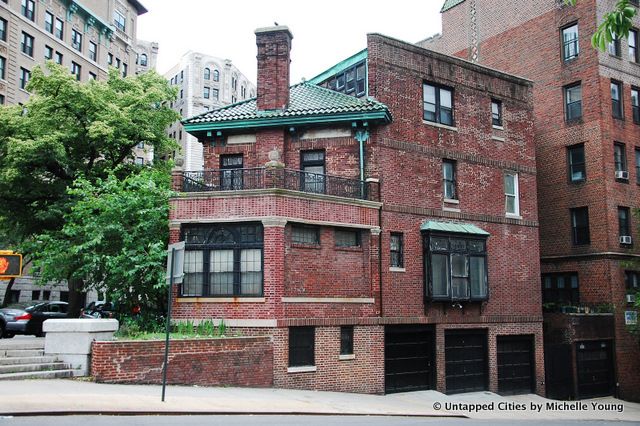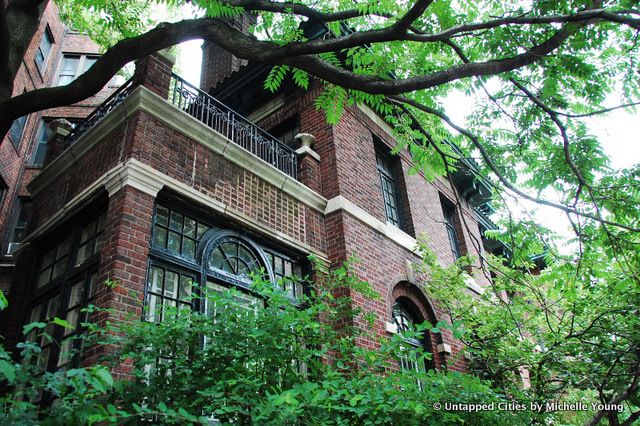Last Chance to Catch NYC's Holiday Notalgia Train
We met the voices of the NYC subway on our nostalgia ride this weekend!


A shared exploration with Gotham Lost and Found.
The recently designated Audubon Park Historic District, an irregularly shaped area bounded by Riverside Drive and Broadway between West 155th and West 158th Streets, offers a rare glimpse of an earlier, bucolic Manhattan. Although the remnants of the house of the famous 19th-century naturalist whose name graces the neighborhood have, in one of the city’s great architectural mysteries, disappeared, the sylvan landscape Audubon valued so highly is still visible in the area’s gentle hills and views of the Hudson. Handsome apartment buildings such as the Grinnell, the Church of the Intercession (considered by its architect, Bertram Grosvenor Goodhue, to be his masterpiece) and the remarkable complex of Beaux Arts museum structures known as Audubon Terrace, only reinforce the elegant atmosphere.
 Berler Houses Rear, with view of garages
Berler Houses Rear, with view of garages
The value of Audubon Park lies in its preservation of building types not visible anywhere else in Manhattan. Chief among these is 809/811 Riverside Drive, an unusual duplex house that resembles an Italian villa looming over the multi-cornered intersection of Riverside, 158th Street, and Morgan Place. Also known as the Berler Houses, the history of 809/811 Riverside has been well documented by historian and Audubon Park resident Matthew Spady. Constructed by clothing manufacturer Nathan Berler in 1922, the house was intended as a model for a larger group of similar duplex houses; although, in the end, only 809/811 Riverside was actually constructed. According to an article dated February 12, 1922 in the New York Times, the houses cost $70,000 to build (roughly $937,000 in today’s figures) and featured a built-in garage, still visible on 158th Street.
 Side view with Solarium and Patio
Side view with Solarium and Patio
Spady has discovered that the houses also contained a Welte orchestrion (a large pneumatic music box filled with pipes and cymbals), built in 1920 and removed when a new owner bought the property in the 1960s. Beyond these features, the houses boasted unique design elements which can still be admired, including a tiled roof (in Spanish mission style), Doric columns, balustrades, arched windows and single-story solariums on both sides, covered with patios.

Due perhaps to their distinctive and striking appearance, the Berler Houses have been the subject of a number of neighborhood legends. One, in particular, asserts they were the homes of the Gershwin brothers, while another claims that Irving Berlin once lived here. Neither story is true, although the houses have sheltered at least one highly distinguished resident. In 1947, according to an article in the Chicago Defender, “Miss Jewel Plummer” was residing at number 809 while working as a teaching fellow in biology at NYU. As Jewel Plummer Cobb (born 1924), she is known today as one of the country’s most important biologists and an African-American pioneer (according to one source, she had initially been denied the NYU fellowship because of her race). Cobb’s groundbreaking research on cancer cells has led to significant advances in the field of chemotherapy.
After being on the market for some years, 809 Riverside Drive was sold in 2010 and its new owners, according to Matthew Spady, have been engaged in a caring process of restoration. According to Spady, it’s been a delight to see the house occupied again. “At Christmas,” he recalls, “they put their tree in the solarium where the whole neighborhood could see it, a lovely gesture signalling that a family is once again in residence.”
David Freeland is the author of Automats, Taxi Dances, and Vaudeville: Excavating Manhattan’s Lost Places of Leisure.

Read more about David and his book right here on Untapped.
Follow Untapped Cities on Twitter and Facebook! Get in touch with the photography @untappedmich.
Subscribe to our newsletter